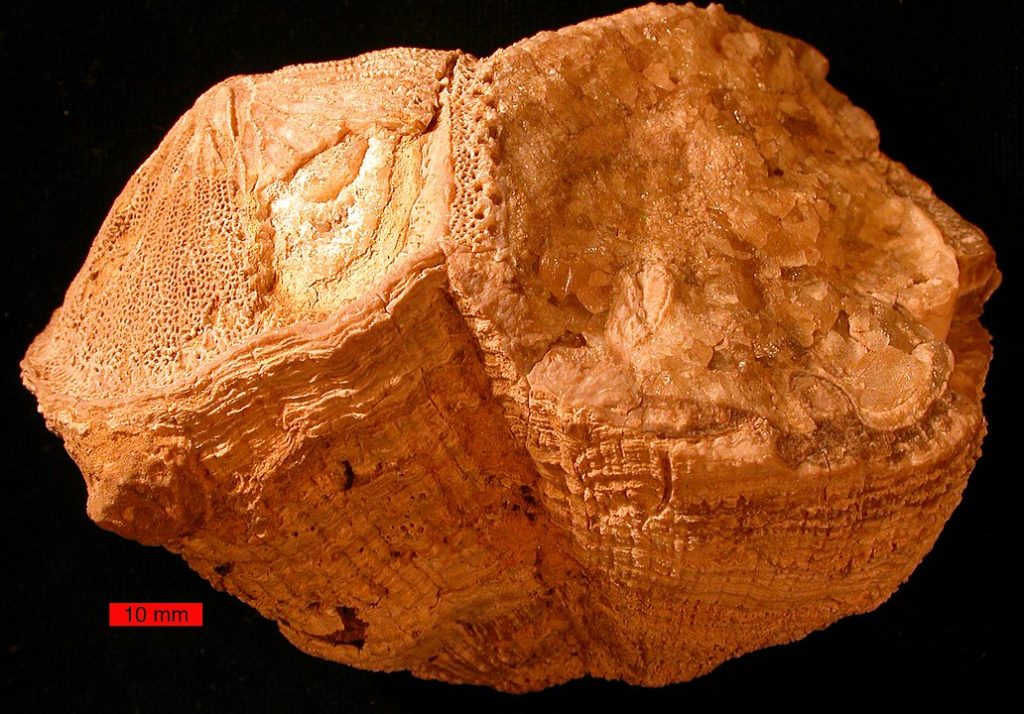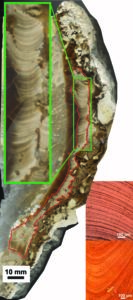Beer stein-shaped distant relative of modern clams captured snapshots of hot days in the late Cretaceous
9 March 2020

Fossil rudist bivalves (Vaccinites) from the Al-Hajar Mountains, United Arab Emirates.
Credit: Wikipedia, Wilson44691 – Own work, Public Domain
AGU contact:
Liza Lester, +1 (202) 777-7494, [email protected]
Contact information for the researchers:
Niels de Winter, Vrije Universiteit Brussel and Utrecht University, +31 6 3444 3433, [email protected]
WASHINGTON—Earth turned faster at the end of the time of the dinosaurs than it does today, rotating 372 times a year, compared to the current 365, according to a new study of fossil mollusk shells from the late Cretaceous. This means a day lasted only 23 and a half hours, according to the new study in AGU’s journal Paleoceanography and Paleoclimatology.
The ancient mollusk, from an extinct and wildly diverse group known as rudist clams, grew fast, laying down daily growth rings. The new study used lasers to sample minute slices of shell and count the growth rings more accurately than human researchers with microscopes.
The growth rings allowed the researchers to determine the number of days in a year and more accurately calculate the length of a day 70 million years ago. The new measurement informs models of how the Moon formed and how close to Earth it has been over the 4.5-billion-year history of the Earth-Moon gravitational dance.
The new study also found corroborating evidence that the mollusks harbored photosynthetic symbionts that may have fueled reef-building on the scale of modern-day corals.
The high resolution obtained in the new study combined with the fast growth rate of the ancient bivalves revealed unprecedented detail about how the animal lived and the water conditions it grew in, down to a fraction of a day.
“We have about four to five datapoints per day, and this is something that you almost never get in geological history. We can basically look at a day 70 million years ago. It’s pretty amazing,” said Niels de Winter, an analytical geochemist at Vrije Universiteit Brussel and the lead author of the new study.
Climate reconstructions of the deep past typically describe long term changes that occur on the scale of tens of thousands of years. Studies like this one give a glimpse of change on the timescale of living things and have the potential to bridge the gap between climate and weather models.
Chemical analysis of the shell indicates ocean temperatures were warmer in the Late Cretaceous than previously appreciated, reaching 40 degrees Celsius (104 degrees Fahrenheit) in summer and exceeding 30 degrees Celsius (86 degrees Fahrenheit) in winter. The summer high temperatures likely approached the physiological limits for mollusks, de Winter said.
“The high fidelity of this data-set has allowed the authors to draw two particularly interesting inferences that help to sharpen our understanding of both Cretaceous astrochronology and rudist palaeobiology,” said Peter Skelton, a retired lecturer of palaeobiology at The Open University and a rudist expert unaffiliated with the new study.
Ancient reef-builders
The new study analyzed a single individual that lived for over nine years in a shallow seabed in the tropics—a location which is now, 70-million-years later, dry land in the mountains of Oman.
Torreites sanchezi mollusks look like tall pint glasses with lids shaped like bear claw pastries. The ancient mollusks had two shells, or valves, that met in a hinge, like asymmetrical clams, and grew in dense reefs, like modern oysters. They thrived in water several degrees warmer worldwide than modern oceans.
In the late Cretaceous, rudists like T. sanchezi dominated the reef-building niche in tropical waters around the world, filling the role held by corals today. They disappeared in the same event that killed the non-avian dinosaurs 66 million years ago.
“Rudists are quite special bivalves. There’s nothing like it living today,” de Winter said. “In the late Cretaceous especially, worldwide most of the reef builders are these bivalves. So they really took on the ecosystem building role that the corals have nowadays.”

Daily and seasonal layers are visible in a cross section through the specimen of the rudist clam Torreites sanchezi analyzed in the new study. The red box highlights well-preserved parts of the shell. The inserts show microscopic images of the daily laminae which are bundled in groups likely linked to the 14/28 day tidal cycles.
Credit: AGU
The new method focused a laser on small bits of shell, making holes 10 micrometers in diameter, or about as wide as a red blood cell. Trace elements in these tiny samples reveal information about the temperature and chemistry of the water at the time the shell formed. The analysis provided accurate measurements of the width and number of daily growth rings as well as seasonal patterns. The researchers used seasonal variations in the fossilized shell to identify years.
The new study found the composition of the shell changed more over the course of a day than over seasons, or with the cycles of ocean tides. The fine-scale resolution of the daily layers shows the shell grew much faster during the day than at night
“This bivalve had a very strong dependence on this daily cycle, which suggests that it had photosymbionts,” de Winter said. “You have the day-night rhythm of the light being recorded in the shell.”
This result suggests daylight was more important to the lifestyle of the ancient mollusk than might be expected if it fed itself primarily by filtering food from the water, like modern day clams and oysters, according to the authors. De Winter said the mollusks likely had a relationship with an indwelling symbiotic species that fed on sunlight, similar to living giant clams, which harbor symbiotic algae.
“Until now, all published arguments for photosymbiosis in rudists have been essentially speculative, based on merely suggestive morphological traits, and in some cases were demonstrably erroneous. This paper is the first to provide convincing evidence in favor of the hypothesis,” Skelton said, but cautioned that the new study’s conclusion was specific to Torreites and could not be generalized to other rudists.
Moon retreat
De Winter’s careful count of the number of daily layers found 372 for each yearly interval. This was not a surprise, because scientists know days were shorter in the past. The result is, however, the most accurate now available for the late Cretaceous, and has a surprising application to modeling the evolution of the Earth-Moon system.
The length of a year has been constant over Earth’s history, because Earth’s orbit around the Sun does not change. But the number of days within a year has been shortening over time because days have been growing longer. The length of a day has been growing steadily longer as friction from ocean tides, caused by the Moon’s gravity, slows Earth’s rotation.
The pull of the tides accelerates the Moon a little in its orbit, so as Earth’s spin slows, the Moon moves farther away. The moon is pulling away from Earth at 3.82 centimeters (1.5 inches) per year. Precise laser measurements of distance to the Moon from Earth have demonstrated this increasing distance since the Apollo program left helpful reflectors on the Moon’s surface.
But scientists conclude the Moon could not have been receding at this rate throughout its history, because projecting its progress linearly back in time would put the Moon inside the Earth only 1.4 billion years ago. Scientists know from other evidence that the Moon has been with us much longer, most likely coalescing in the wake of a massive collision early in Earth’s history, over 4.5 billion years ago. So the Moon’s rate of retreat has changed over time, and information from the past, like a year in the life of an ancient clam, helps researchers reconstruct that history and model of the formation of the moon.
Because in the history of the Moon, 70 million years is a blink in time, de Winter and his colleagues hope to apply their new method to older fossils and catch snapshots of days even deeper in time.
###
AGU (www.agu.org) is an international association of more than 60,000 advocates and experts in Earth and space science. Through our initiatives, such as mentoring, professional development and awards, AGU members uphold and foster an inclusive and diverse scientific community. AGU also hosts numerous conferences, including the largest international Earth and space science meeting as well as serving as the leading publisher of the highest quality journals. Fundamental to our mission since our founding in 1919 is to live our values, which we do through our net zero energy building in Washington, D.C. and making the scientific discoveries and research accessible and engaging to all to help protect society and prepare global citizens for the challenges and opportunities ahead.
Notes for Journalists
This paper is freely available until April 15. Journalists and public information officers (PIOs) can download a PDF copy of the article by clicking on this link: https://agupubs.onlinelibrary.wiley.com/doi/full/10.1029/2019PA003723
Journalists and PIOs may also request a copy of the final paper by emailing Liza Lester at [email protected]. Please provide your name, the name of your publication, and your phone number.
Neither the paper nor this press release is under embargo.
Paper Title
“Sub-daily scale chemical variability in a Torreites sanchezi rudist shell: Implications for rudist paleobiology and the Cretaceous day-night cycle”
Authors
Niels J. de Winter, Steven Goderis, Matthias Sinnesael, Stef Vansteenberge and Philippe Claeys, Analytical, Environmental and Geochemistry research group, Vrije Universiteit Brussel, Brussels Belgium
Stijn J.M. Van Malderen, Joke Belza and Frank Vanhaecke, Atomic and Mass Spectrometry (A&MS) research unit, Department of Chemistry, Ghent University, Ghent, Belgium
Christophe Snoeck, Analytical, Environmental and Geochemistry research group, Vrije Universiteit Brussel and Laboratoire G-Time, Département Géosciences, Environment et Societé, Université Libre de Bruxelles, Brussels, Belgium